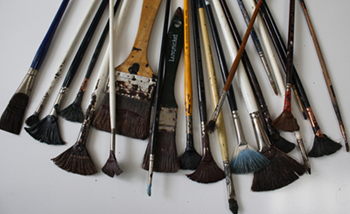With my “WAX” medium, I experimented with different techniques. I developed my encaustic wax technique, where I start by covering paper with a thick coat of melted beeswax. Wax comes in different colors, but I prefer ‘Burnt umber’, ‘Burnt sienna’, ‘Black’, and mixes of these three to create an overall uniform tone. Sometimes I use the water base paint to apply a colored underlay on the paper before I covered it with the wax. The surface itself may also be warmed to allow for the manipulation of the encaustic paint. It may also be cooled immediately ‘freeze’ the brush strokes that are applied to it. After the wax overlay cools down, I scratch out images on the dark box. Then, I might use oil paints or color pencils to apply more detailed variations in color and tone. When this is finished, the artwork has a slight three-dimensional feel to it, though it is on a two -dimensional surface. This is the effect that I was looking for . It is comfortable and gives me the feel of both painting and sculpturing.
Encaustic beeswax painting is the oldest fine art technique in history. Encaustic literally means ‘burning In’. This durable medium dates back over two thousand years ago to the days of the Rome, ancient Greece, and even Egypt. Around the Middle Ages, artists turned to tempera, fresco and ultimately oil paint. Although encaustic painting was overshadowed by these simpler painting techniques, it was never completely abandoned. Encaustic is an incredibly versatile, solvent-free medium, eliminating the need for turpentine and mineral spirits. Encaustic highly resistant to yellowing effect, weathering, moisture, and high temperatures, even more so than oil paint.
about WAX [pdf file]




